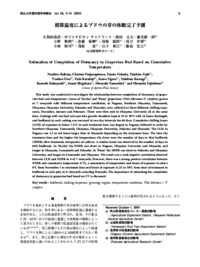

Scientific Reports of the Faculty of Agriculture, Okayama University
Published by the Faculty of Agriculture, Okayama UniversityONLINE ISSN : 2186-7755
Permalink : http://escholarship.lib.okayama-u.ac.jp/14481
Estimation of Completion of Dormancy in Grapevine Bud Based on Cumulative Temperature
Potjanapimon, Chaiwat
Fujiia, Yuichiro
Ono, Toshiro
Kaken ID
researchmap
Kurafuji, Yuki
Ogoro, Atsuo
Kunugi, Yukihiro
Kobayashi, Kazushi
Shigehara, Izumi
Yamashita, Hiroyuki
Fujishima, Hiroyuki
Published Date
2009-02
Abstract
This study was conducted to investigate the relationship between completion of dormancy of grapevine
bud and temperature. Canes of ‘Kyoho’ and ‘Pione’ grapevines (Vitis labrusca×V. vinifera) grown in 7 vineyards with different temperature conditions, in Nagano, Northern Okayama, Yamanashi, Okayama, Okayama University, Fukuoka and Miyazaki, were collected at three different chilling exposures,
December, January and February. These were then sent to Okayama University all at the same time. Cuttings with one bud were put into growth chambers kept at 25 or 30°C with 14 hours daylength, and budbreak in each cutting was surveyed at two day intervals for 60 days. Cumulative chilling hours (CCH) of exposure to below 7.2°C in each treatment time was largest in Nagano, followed in order by Northern Okayama, Yamanashi, Okayama, Okayama University, Fukuoka and Miyazaki. The CCH in Nagano was 2.5 to 4.8 times larger than in Miyazaki depending on the treatment time. The later the treatment time and the higher the temperature, the fewer were the number of days to first budbreak (NDFB) after treatment, irrespective of cultivar. A similar trend was observed in the number of days to 60% budbreak. In ‘Kyoho’ the NDFB was short in Nagano, Okayama University and Miyazaki, and longer in Okayama, Yamanashi and Fukuoka. In ‘Pione’ the NDFB was short in Fukuoka and Okayama University, and longer in Yamanashi and Okayama. The result was a weak negative correlation observed between CCH and NDFB in 4 of 7 vineyards. However, there was a strong positive correlation between NDFB and cumulative temperature (CT), a summation of temperature and hours of exposure to above 0°C from November 1 to treatment time and hours of exposure to 25 or 30°C from start of treatment to budbreak in each plot, in 6 vineyards excluding Miyazaki. The importance of estimating the completion of dormancy in grapevine bud based on CT is discussed.
Keywords
budbreak
chilling exposure
growing region
temperature condition
Vitis labrusca × V. vinifera
ISSN
0474-0254
NCID
AN00033029
